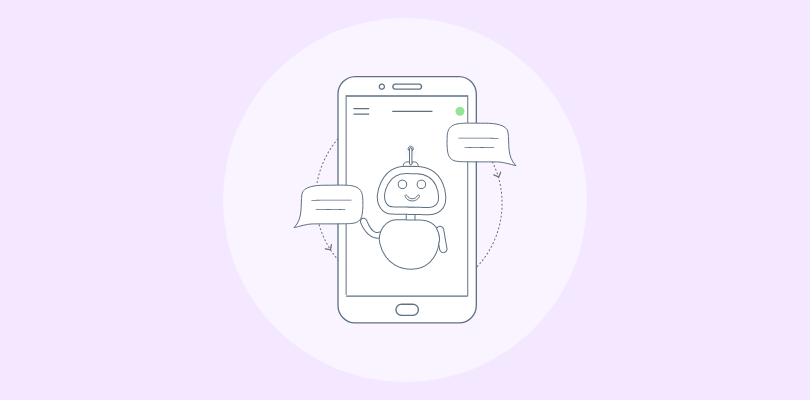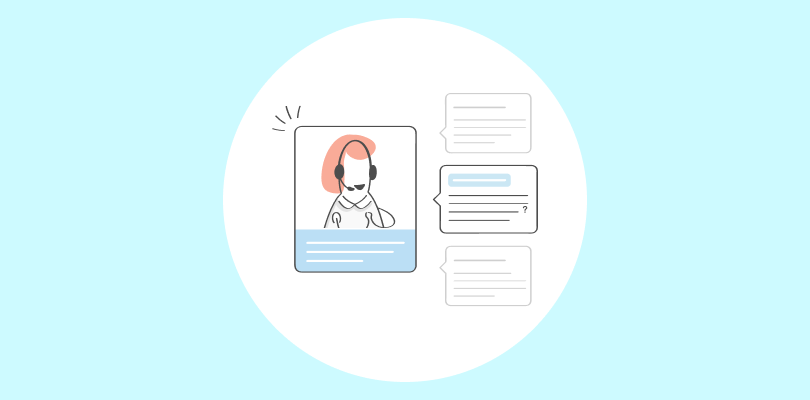How do you engage your customers, communicate with them, understand their needs, and offer solutions?
It’s simple: By creating customer engagement strategies.
And how do you measure and improve your customer engagement strategies?
Well, with the right customer engagement tools!
Hundreds of customer engagement tools are available in the market, each with unique features, benefits, and drawbacks. It’s when choosing the best ones for your business becomes overwhelming and time-consuming.
That’s why I have done the research for you and compiled a list of the 10 best customer engagement tools I’ve tried in my professional career.
These tools cover different aspects of customer engagement, such as communication, engagement (popups), feedback, email marketing, and analytics. They are easy to use, affordable, and effective.
But first, here’s a summary of each tool:
| Customer Engagement Tool | Best For | Paid Plan |
|---|---|---|
| ProProfs Chat | Customization and In-Depth Reports | Forever-free for a single operator. Paid plan starts at $19.99/operator/month. |
| Tidio | Chatbot Support | Starts at $0. Paid plan starts at $29/month. |
| Tawk.to | User-Friendly Dashboard | Free forever. |
| Picreel | Exit-Intent Popups | Free plan is available. Paid plan starts at $9.99/10000 visitors/month. |
| OptinMonster | Lead Generation | Starts from $9/month. |
| Poptin | Customizing Popups | Free plan available. Paid plan starts at $20/month. |
| Qualaroo | Collecting Contextual Feedback | Starts at $69/month. A 15-day free trial is available. |
| InMoment | Omnichannel Feedback Collection | Custom Pricing. |
| BIGContacts | Contact Management and Email Marketing | Starts at $5/user/month. A 15-day free trial is available. |
| Sender | Marketing Automation | Free plan is available. Paid plan starts at $10/month. |
| Google Analytics | Goal Tracking | Custom Pricing. |
| Segment | AI-Powered Data Collection | Free plan is available. Paid plan starts at $120/month. |
But wait, why should you trust my list?
I have years of experience in the customer support industry and firsthand experience with most tools on the list. I have also included tools recommended by my industry peers and the top-rated review sites.
Now, let’s begin.
Communication Tools
Effective customer engagement relies on consistent, personalized, and timely communication. Communication tools facilitate real-time interaction, automated messaging, chatbot creation, and enhancing communication.
They also aid in conversation tracking, data collection, and seamless integration with other tools. Here are three of the best communication tools for customer engagement:
1. ProProfs Chat
Best for Customization and In-Depth Reports
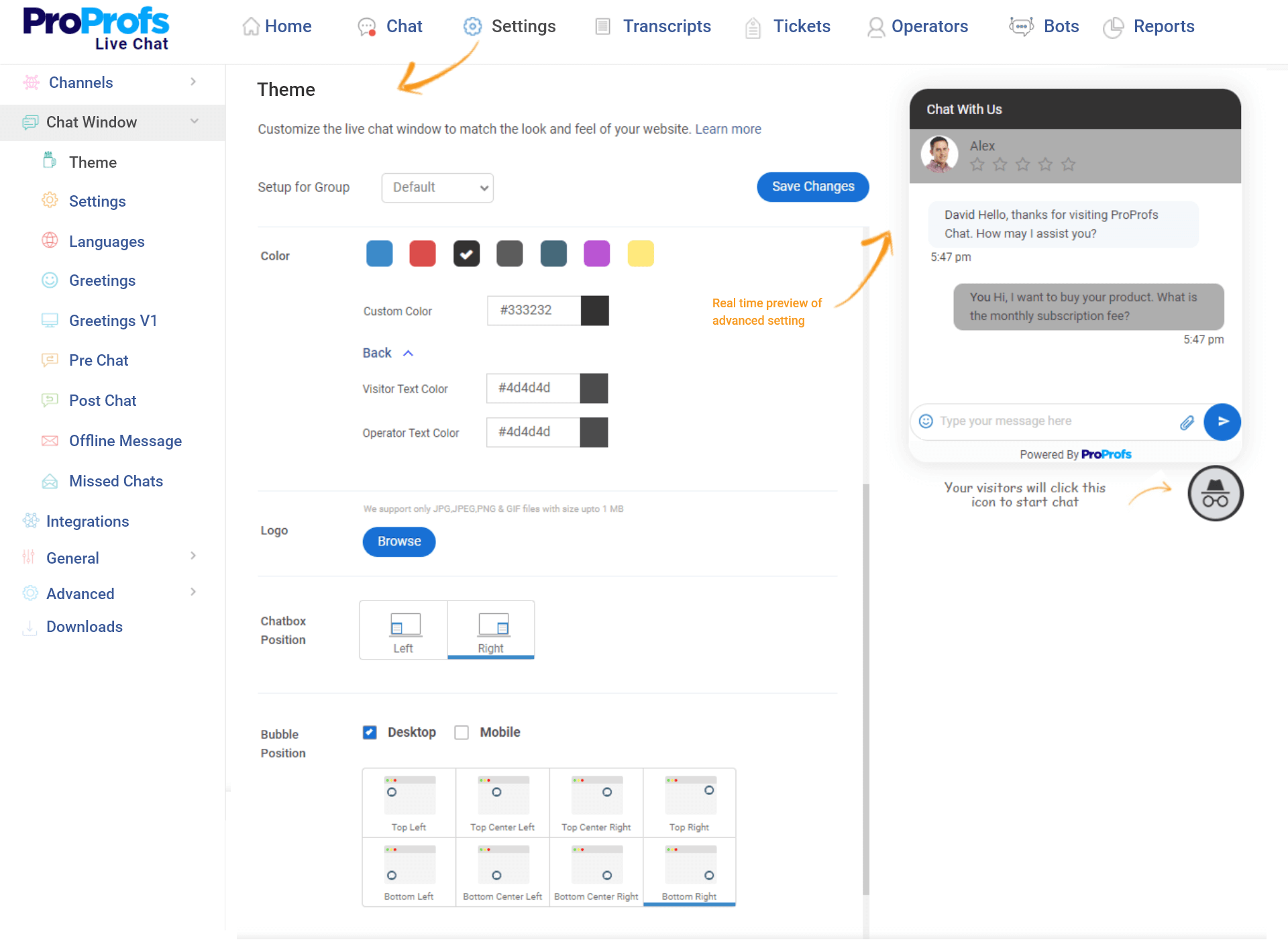
ProProfs Chat is my go-to communication tool for customer support and engagement. This live chat software offers a seamless and interactive way to connect with website visitors and customers.
The best part is it allows me to easily customize chat widgets to match my brand’s look and feel. Its real-time visitor tracking is excellent for understanding user behavior. It also enabled me to provide personalized assistance and boost conversions.
The robust reporting and analytics provided by ProProfs Chat have been instrumental in making data-driven decisions for improving customer support strategies. Also, the proactive chat invitations ensure I engage with potential customers at the right moment, increasing sales and customer satisfaction.
To summarize, ProProfs Chat has significantly enhanced my customer support and engagement efforts, making it an indispensable tool for my business.
What you’ll like:
- Intelligent chat routing that assigns chats to the right agents based on their availability and skills.
- Canned responses that ensure error-free responses by using predefined messages for common queries.
- Single sign-on to simplify operator authentication.
- AI-powered chatbots to automate repetitive tasks and save time.
- Seamless integration with ProProfs Knowledge Base to offer self-help articles.
- Chat transcripts to access past customer conversations for a personalized experience.
What you may not like:
- Frequent updates on the AI chatbot can get overwhelming for new users.
- The free plan is limited to a single operator.
Pricing: A free-forever plan is available. Live chat pricing starts from $19.99/operator/month.
2. Tidio
Best for Chatbot Support
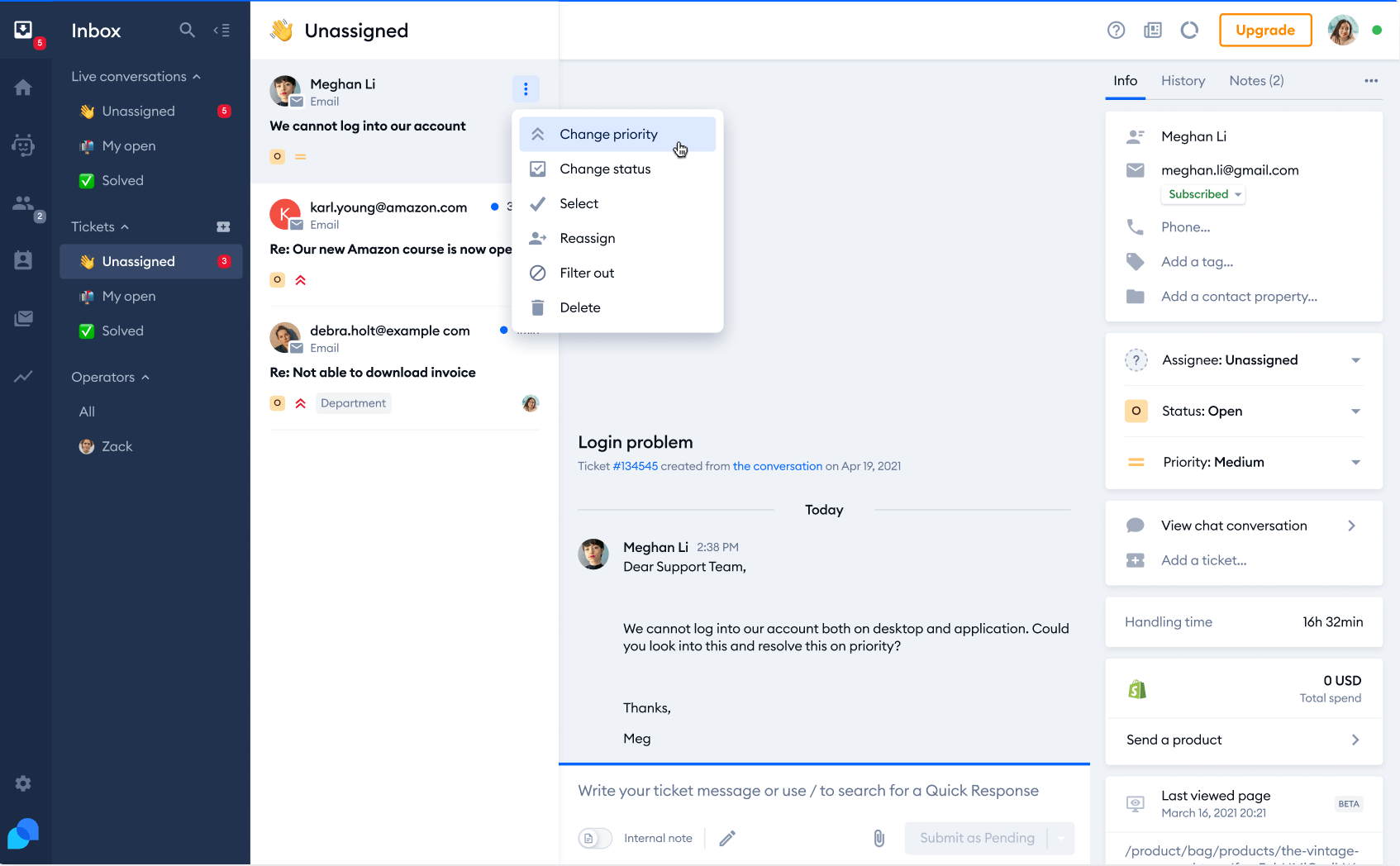
Tidio is a versatile live chat and chatbot platform that facilitates engaging customer interactions. The tool impressed me with its simplicity and versatility.
The chat widget integration was straightforward, ensuring I could start conversations with visitors quickly.
Tidio’s chatbots were especially handy for automating responses to common questions, reducing the workload on our support team. Additionally, the platform allowed me to send automated messages based on visitor behavior, a great way to engage users and boost conversions proactively.
Its mobile app was convenient for staying connected on the go, and the email notification feature ensured I never missed an important chat.
While I have moved on to other tools, my experience with Tidio was positive as it served as a reliable customer engagement tool for my website visitors.
What you’ll like:
- Omnichannel communication to chat with your users across different platforms, such as email, Facebook Messenger, etc.
- Visitor tracking to know who is on your website, what they are doing, and where they are from.
- Live typing to see what your users are typing before they send their messages.
- Offline mode to send messages to visitors when they are not online.
- Multi-language support to chat with your users in their preferred language.
What you may not like:
- The free plan is limited to three chatbots and 100 contacts per month.
- The pricing plans are based on the number of contacts rather than the number of chats or features.
- The chatbot editor may not be very intuitive or flexible for some users.
Pricing: Starts at $0 (limited to 100 chatbot triggers). Paid plan starts at $29/month.
3. Tawk.to
Best for User-Friendly Dashboard
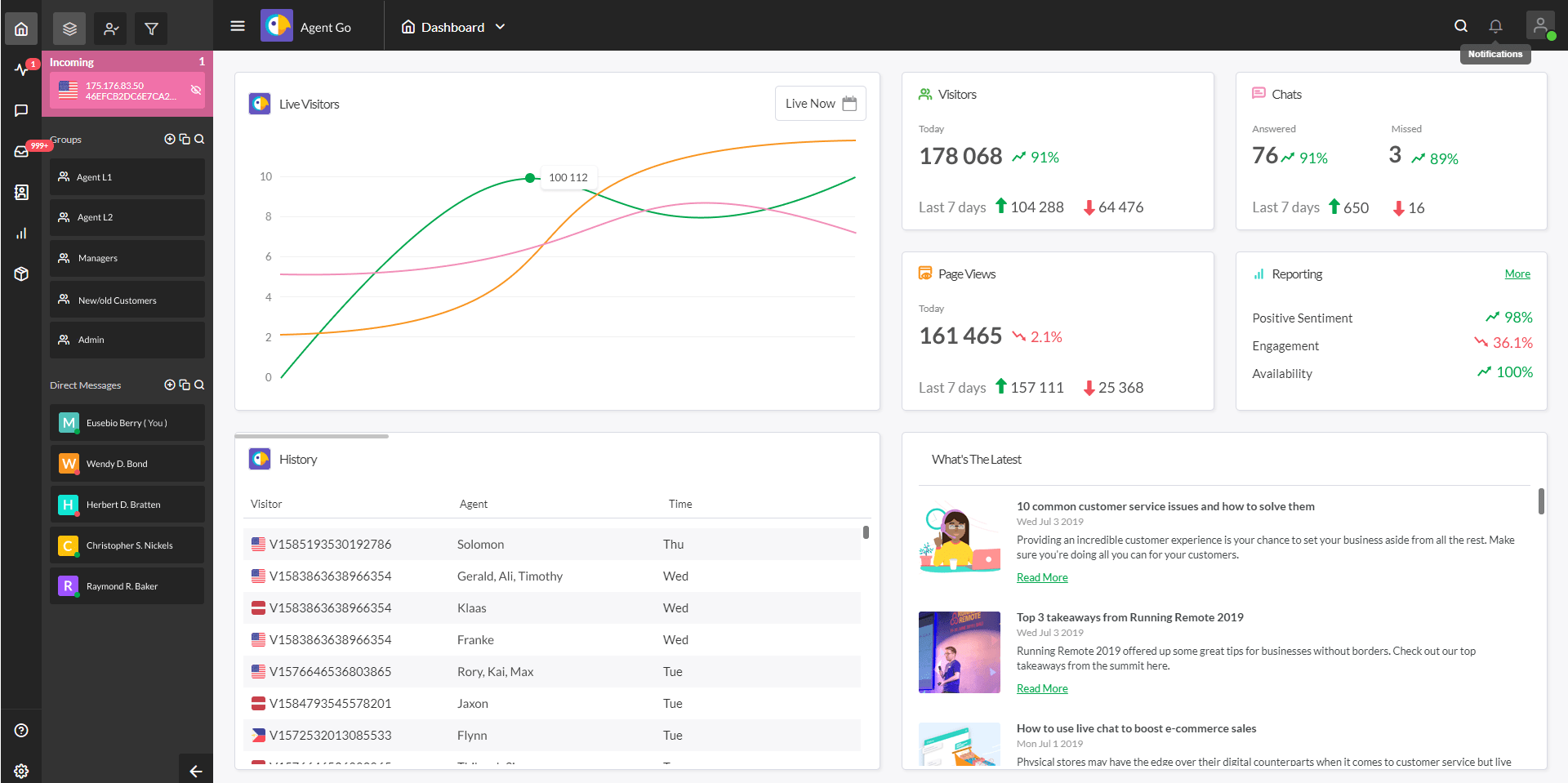
I highly recommend the Tawk.to tool for anyone looking to add live chat to their website. The best part is it’s entirely free! The setup was remarkably straightforward.
What truly distinguished Tawk.to was its intuitive dashboard. I could invite team members, create shortcuts for quick responses, and seamlessly engage with my website visitors.
This tool also made tracking my team’s performance and examining chat history easy. It also offered a real-time visitor monitoring feature to track visitor activity, including the pages they’re on, visit frequency, and their entire customer journey.
What you’ll like:
- Customizable chat widget with different colors, themes, and languages.
- Triggers and shortcuts to automate responses and save time.
- File sharing to send and receive images, documents, and other files.
- Ticketing system to manage offline messages and support requests.
What you may not like:
- Tawk.to’s automation features are basic compared to some competitors, which aren’t suitable for users seeking advanced automation options.
- Limited reporting and analytics since it is free.
Pricing: Starts at $0.
Popup Tools
Popup tools help you create and manage popups on your website to boost lead generation, increase conversions, and reduce bounce rates. They allow you to design popups that suit your brand and purpose.
They also help target popups to specific audiences based on their location, device, behavior, etc. Here are three of the best popup tools for customer engagement:
4. Picreel
Best for Exit-Intent Popups
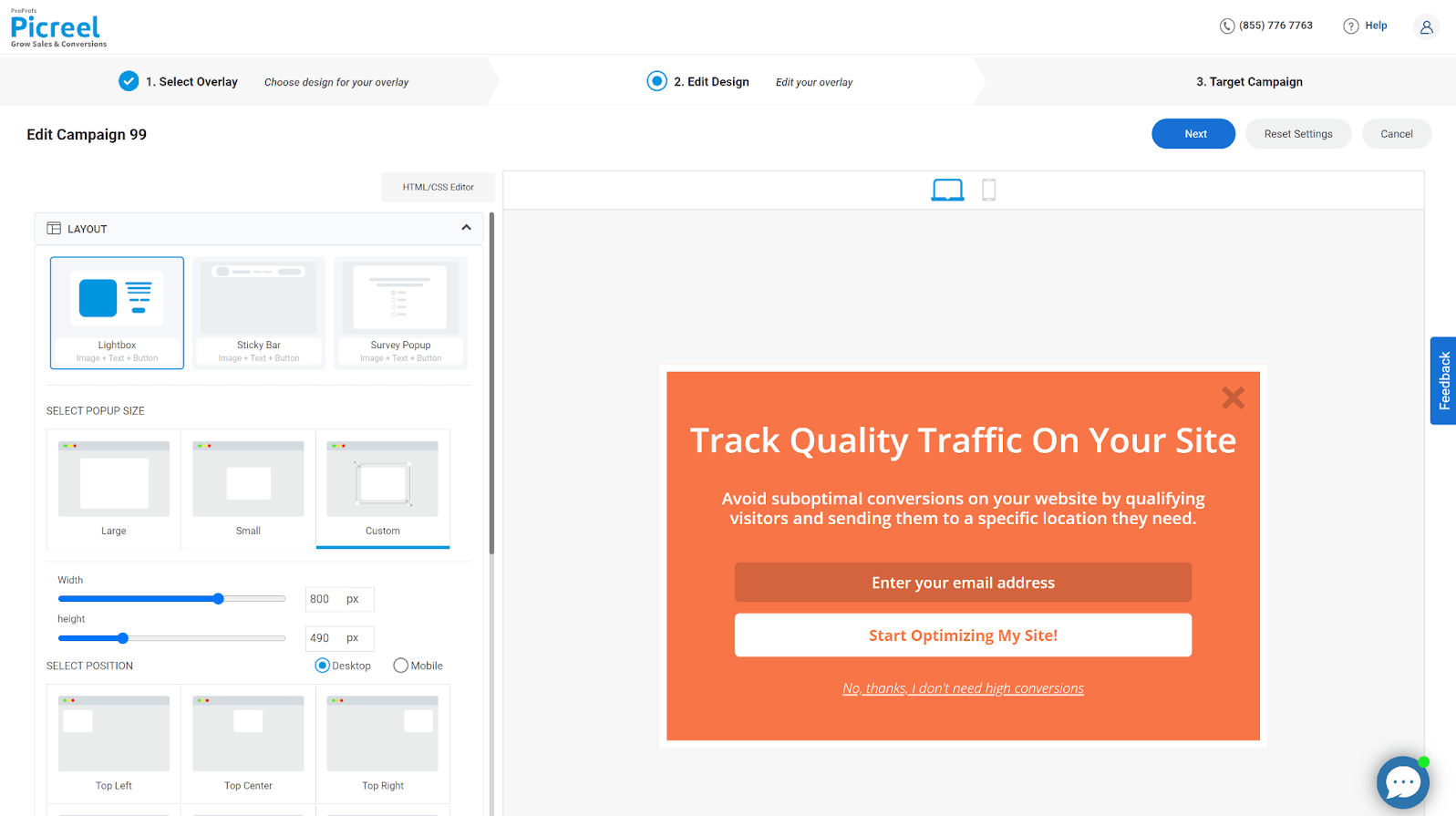
I have been using Picreel for a while now, and I’ve experienced a significant increase in sales and leads from my existing traffic. With its exit-intent overlay, the software engages visitors before they leave.
Picreel also offers lead generation forms that boost your contact lists by capturing qualified visitors’ email addresses and phone numbers. The tool provides over 100 delightful popup templates proven to convert. Whether I prefer ready-made designs or want to customize my own, Picreel offers this flexibility.
It’s designed to track visitors’ digital footprints and click behavior in real time, allowing me to serve the most relevant offers as they navigate the content.
Whether it’s about reducing cart abandonment, recommending additional products, offering discounts, or conducting surveys, Picreel ensures I never miss an opportunity to engage with my visitors.
What you’ll like:
- Targeted popups based on visitor behavior, location, device, etc.
- A/B testing to compare different popup designs and optimize conversions.
- Popup guides to promote your best-selling products and pages.
- Analytics and reports to track popup performance and conversion rates.
- Integration with popular platforms such as WordPress, Shopify, Mailchimp, etc.
What you may not like:
- Needs more industry-specific popup templates.
- The reporting section needs a filtering option.
Pricing: A free plan is available. Paid plan starts at $9.99/10000 visitors/month.
Also Read: Live Chat for Customer Support: A Complete Beginner’s Guide
5. OptinMonster
Best for Lead Generation
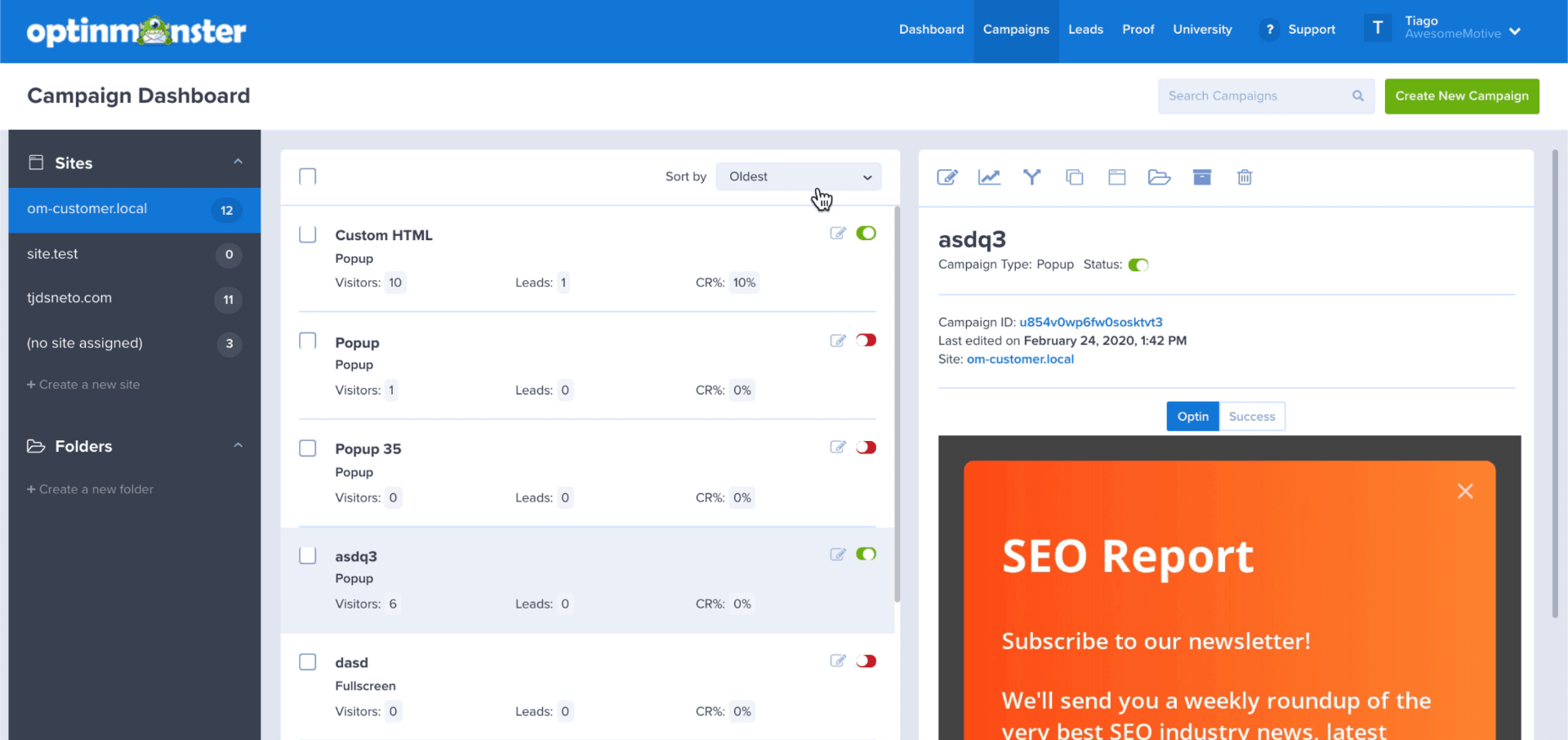
OptinMonster is highly recommended by my peers for enhancing website performance. This conversion optimization toolkit is known for helping businesses convert and monetize website traffic effectively.
The tool offers an Advanced Traffic Redirection feature to send traffic to important pages on your website.
Another notable feature is its Page Level Targeting, allowing you to segment your leads based on visitor behavior and show tailored offers. It can be a good tool if you’re looking for effective lead targeting.
What you’ll like:
- Campaign types such as lightbox popups, fullscreen overlays, slide-ins, floating bars, etc.
- Smart triggers include exit-intent, scroll depth, inactivity sensor, etc.
- Personalization and segmentation to show relevant offers to different visitors based on their interests, behavior, location, etc.
- Conversion analytics to measure the effectiveness of each popup campaign and optimize conversions.
- MonsterLinks that turn any link or image into a popup trigger.
What you may not like:
- Basic plan does not offer A/B testing capabilities.
- Doesn’t have a native CRM feature to help you manage leads.
Pricing: Starts from $9/month.
6. Poptin
Best for Customizing Popups
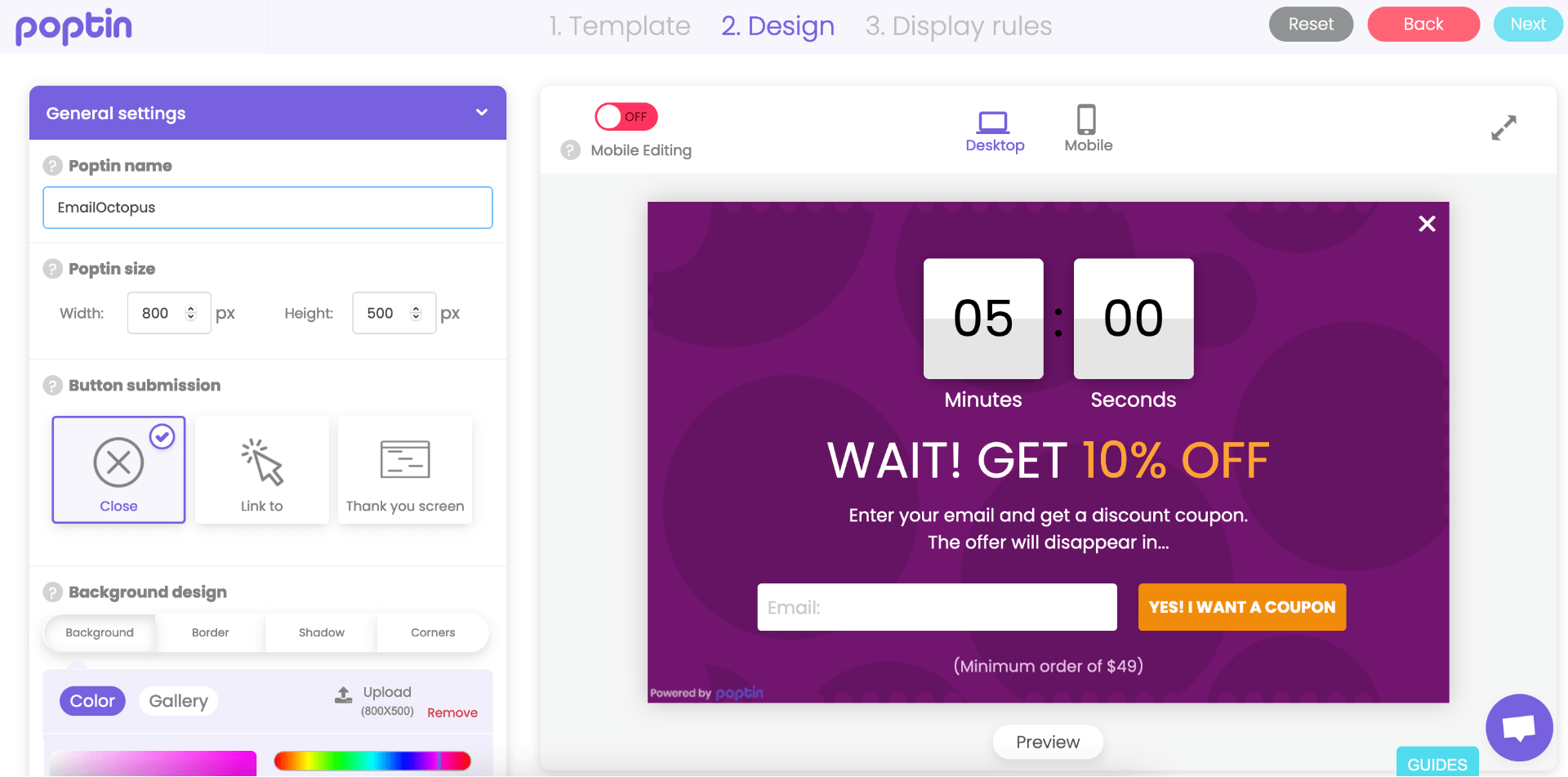
I stumbled upon Poptin early in my career and found it user-friendly. It empowered me to create engaging popups and forms for my website without needing any coding skills.
With its intuitive interface, I could craft customized popups that displayed the right message at the right time, capturing more leads and reducing shopping cart abandonment.
The tool even allowed me to conduct surveys, gather valuable feedback, and engage visitors they’d genuinely be interested in.
Plus, I could automatically send welcome emails and coupons to new subscribers, enhancing their experience and boosting conversions.
What you’ll like:
- Advanced targeting to show popups based on visitor attributes, such as device type, browser type, referral source, etc.
- Triggers that allow you to show popups based on different events, such as exit intent, scroll depth, time on site, etc.
- Rules to set conditions for showing popups based on frequency, duration, page views, etc.
- Animations to add motion and effects to your popups.
- Social proof feature that displays real-time data and testimonials to increase trust and credibility.
What you may not like:
- Lacks advanced features like geo-location targeting, A/B testing, etc.
- Phone support is available only in the most premium pricing plan.
Pricing: Free plan available (without autoresponders). Paid plan starts at $20/month.
Customer Feedback and Survey Tools
Customer feedback survey tools help you collect and analyze customers’ opinions and experiences. You can create and distribute surveys, polls, quizzes, etc., to your customers to get actionable feedback.
Following are the two best customer feedback and survey tools:
7. Qualaroo
Best for Collecting Contextual Feedback
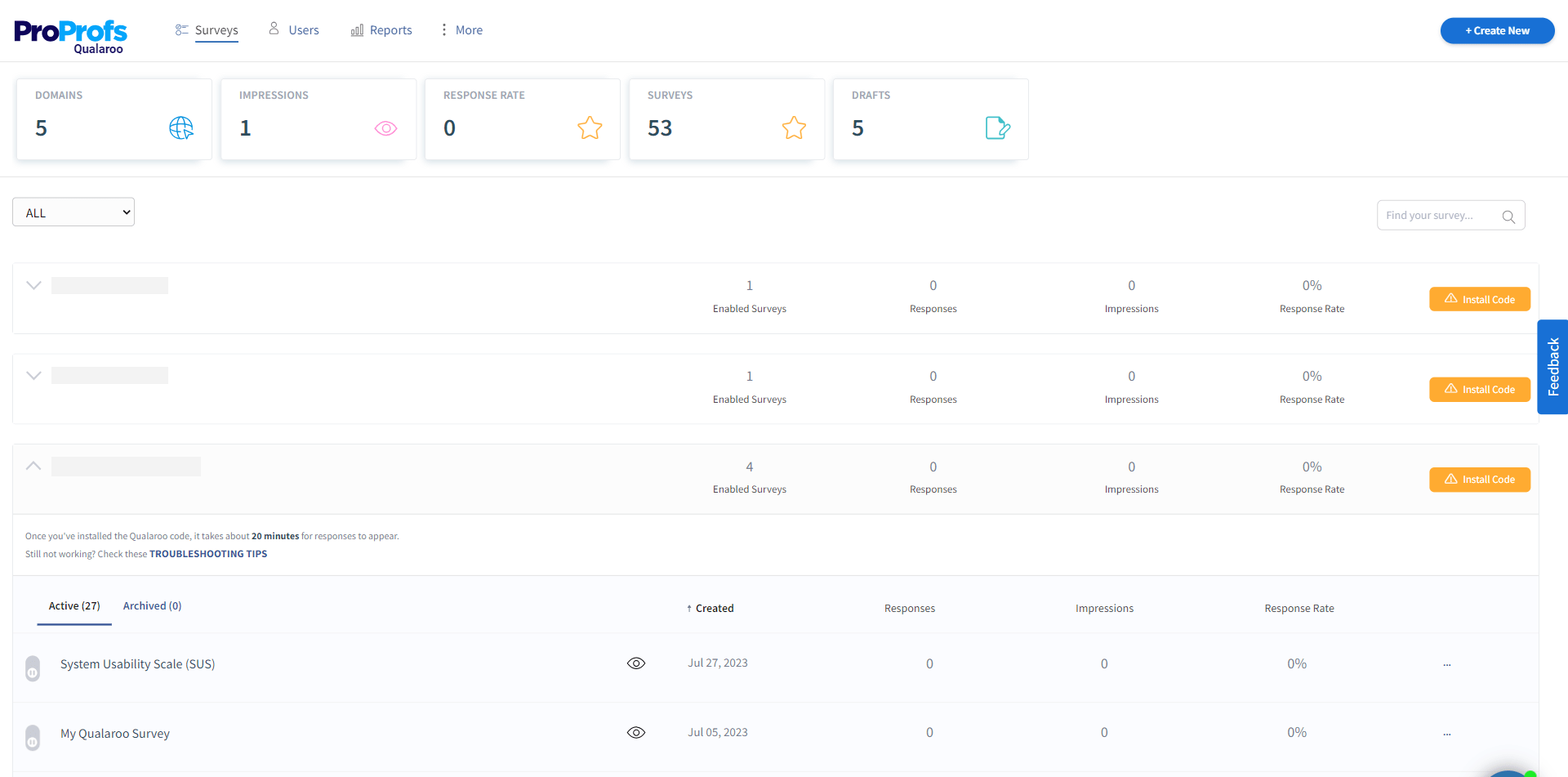
For collecting customer feedback and gauging their sentiment, Qualaroo has been ‘The tool.’ I can engage with my website or app visitors at precisely the right moment, ensuring I capture real-time, actionable insights.
Qualaroo’s advanced targeting feature enables you to ask the right questions to the right users. You can target specific users based on their actions, behavioral patterns, events, or locations.
For example, you can use exit-intent surveys to collect contextual feedback on why visitors leave your website without completing an action.
Another amazing feature is AI analytics, especially sentiment analysis, which allows me to turn free-form text into organized data, track mood metrics, and identify keywords across customer responses.
What you’ll like:
- Pop-up lead generation form to capture your visitor’s attention instantly.
- Net Promoter Score (NPS), Customer Effort Score (CES), Exit-intent, and other pre-designed survey templates.
- Lead targeting based on demographics, browser, device, on-page activity, time spent on a page, etc.
- Skip and branching logic to gather accurate feedback from targeted customer segments.
- Integration with tools like Salesforce, HubSpot, ProProfs Survey, etc.
What you may not like:
- Free trial may not seem sufficient to try all the advanced features.
- Basic UI of the dashboard.
Pricing: Starts at $69/month. A 15-day free trial is available.
8. InMoment
Best for Omnichannel Feedback Collection
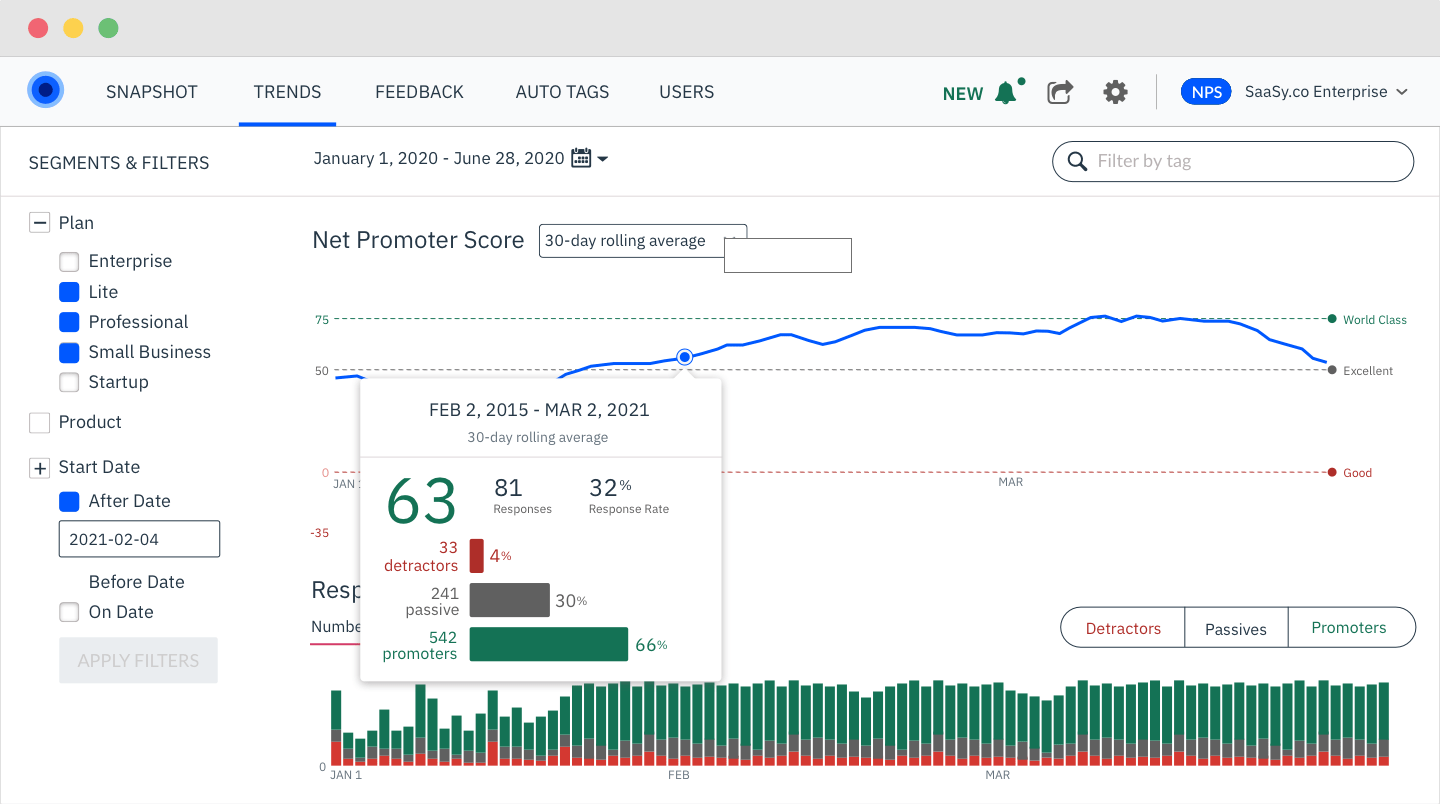
My team used InMoment for a good while, and let me tell you, it transformed how we collected customer feedback at every stage of our journey. Whether creating surveys from scratch or customizing survey templates, InMoment’s Survey Builder has made it easy.
One of its best parts was its omni-channel feedback capability. InMoment allowed us to reach every customer segment through their preferred channels, from surveys and email to SMS and call centers. Doing so ensured we listened to the voice of our customers wherever it came from.
Another feature that streamlined our operations was the Rapid Resolution Engine. It employed AI to instantly resolve customer inquiries, directing them to the right answers and resources in real time.
What you’ll like:
- AI-powered Engagement Engine to intelligently listen and respond to customers.
- Action management to prioritize and execute actions based on feedback data.
- Text analytics to extract insights from unstructured text data using natural language processing.
- Benchmarking to compare your performance with industry standards and best practices.
- Integration with platforms like HubSpot, Salesforce, and Marketo.
What you may not like:
- Limited self-service options for customization and configuration.
- May be complex for users who need a simple feedback solution.
Pricing: Custom pricing.
Email Marketing Tools
Email marketing tools help you create and send email campaigns to your customers. You can design email templates, write email copy, and segment email lists.
Here are two of the best email marketing tools for customer engagement:
9. BIGContacts
Best for Contact Management and Email Marketing
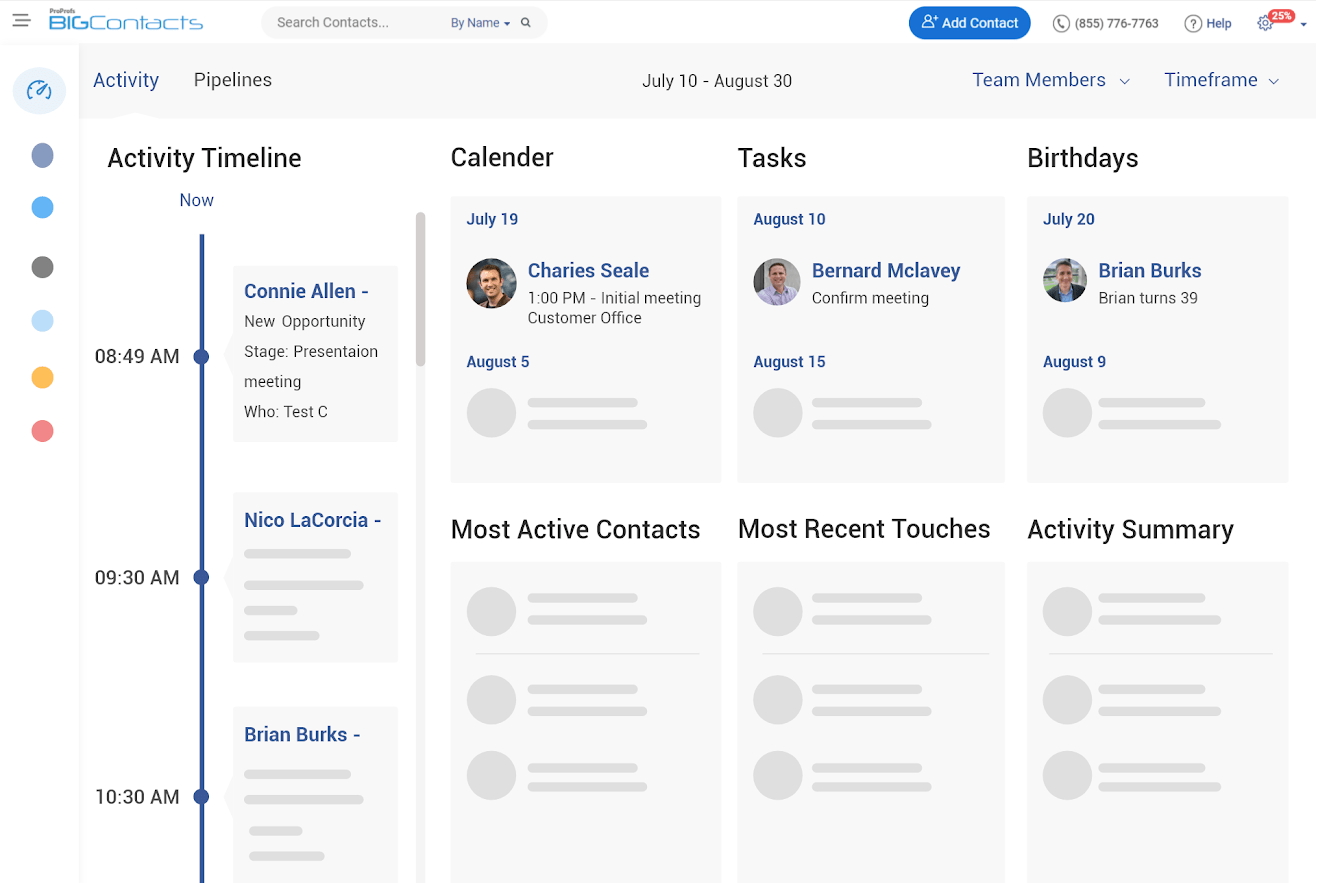
BIGContacts continues to be my favorite CRM tool for managing customer relationships with precision and ease. It’s my team’s central hub for storing, tracking, and nurturing our leads and customer interactions.
What I like the most about this tool is its email marketing capabilities. BIGContacts empowers my team to create and send targeted email campaigns, track their performance, and automate follow-ups based on user behavior.
Another add-on is its contact management capabilities. Its customizable contact profiles allow us to capture essential contact information and personalize our marketing campaigns effectively.
What you’ll like:
- A 360° view of all activity with contacts, tasks, and calendars.
- Social media tracking and drip marketing to retain more customers.
- Simple and easy-to-use interface that can be tailored to fit any business.
- Customizable sales pipeline and automated email marketing based on sales stages.
- Smart reporting and analytics system that tracks sales and team performance.
What you may not like:
- Limited storage in the lower-tier plans may pose limitations for large enterprises.
- The free trial duration is brief to explore all the CRM and email marketing functionalities.
Pricing: Starts at $5/user/month. A 15-day free trial is available.
10. Sender
Best for Marketing Automation
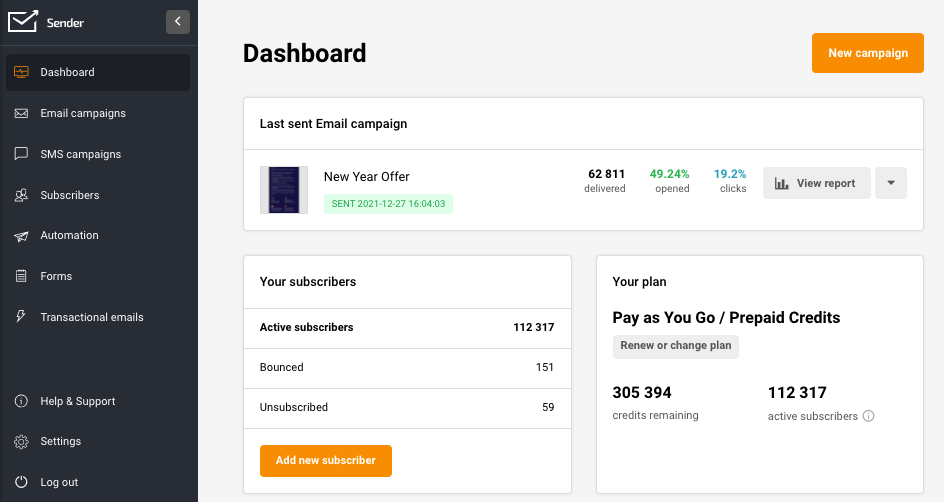
Sender is an all-in-one solution for attracting, nurturing, and converting leads into loyal customers. Having used this powerful marketing tool, I can attest to its efficiency.
It excels at omnichannel marketing, combining the strengths of email and SMS marketing. The platform provides robust reporting and analytics tools that help in monitoring campaign performance effectively.
What is truly amazing about this software is its marketing automation capabilities, which make it effortless to set up automated campaigns that yield remarkable results. The pre-made automation sequences and customization options allowed a tailored approach to engaging and converting leads.
What you’ll like:
- The Deliverability feature ensures your emails reach your customers’ inboxes, not their spam folders.
- Analytics to provide insights into your email performance, such as opens, clicks, bounces, etc.
- Video emails allow you to embed videos in your emails to make them more engaging and interactive.
- List management to segment your subscribers and target them with relevant messages.
What you may not like:
- Users complain about its non-responsive customer support.
- Limited number of email templates.
Pricing: A forever plan is available (limited to 2500 subscribers). Paid plan starts at $10/month.
FREE. All Features. FOREVER!
Try our Forever FREE account with all premium features!
User Analytics Tools
User analytics tools help you track and analyze user behavior on your website or app. They allow you to collect and visualize data like page views, sessions, bounce rate, conversion rate, etc.
Following are the three best user analytics tools for customer engagement:
11. Google Analytics
Best for Goal Tracking
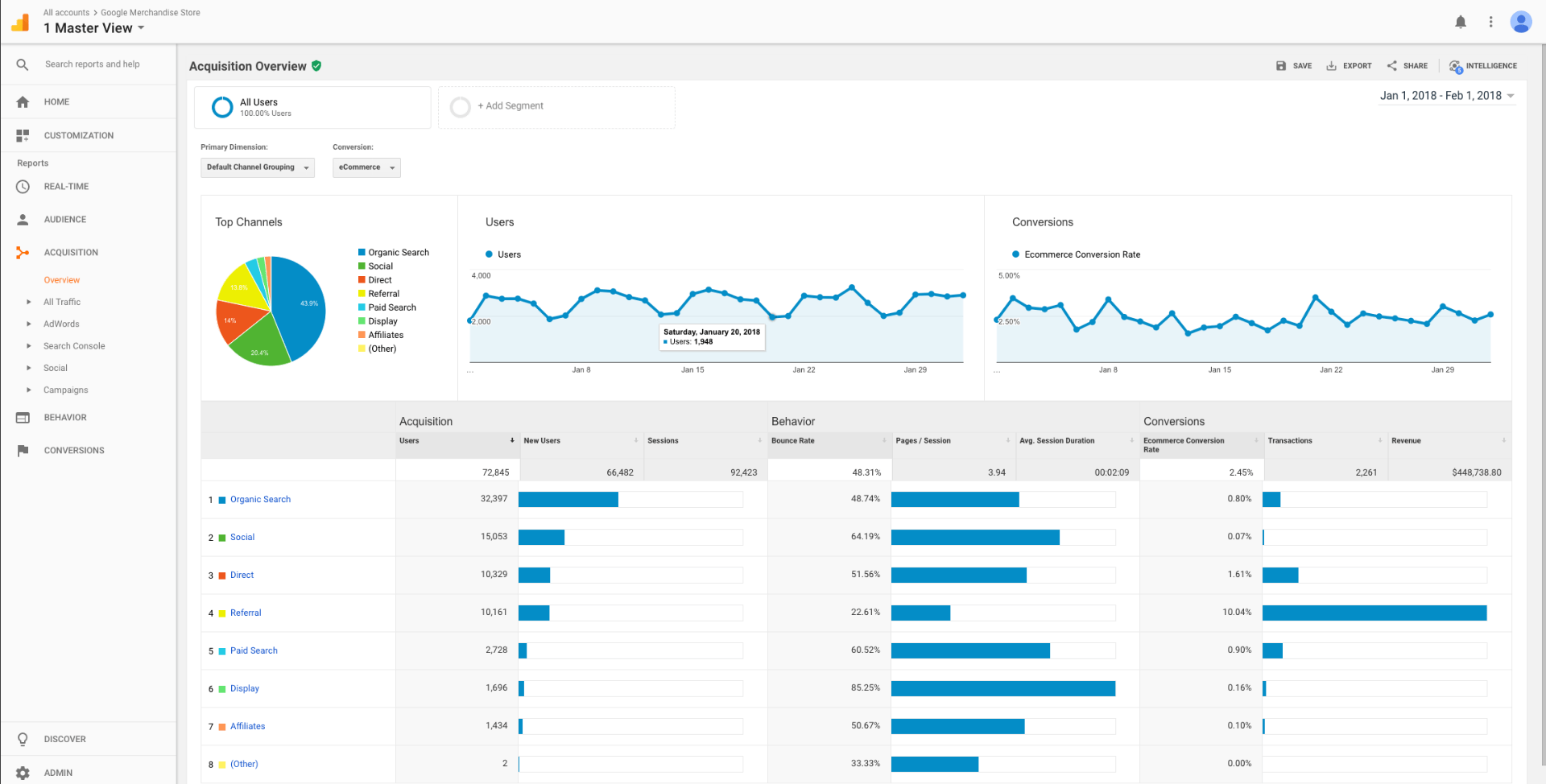
Google Analytics is a powerful tool when it comes to web analytics. Having used this tool extensively, I can attest to its robust capabilities. You can use it to track various metrics, such as traffic sources, audience demographics, user actions, etc.
One of the best things about this software is goal tracking, which allows you to measure user actions on your site, such as form submissions or product purchases. The customizable dashboards and reports make it easy to visualize data and tailor insights to your needs.
Google Analytics is easy to use and configure. You can create reports using a drag-and-drop interface or choose from various templates. The tool also lets you customize the reports according to your needs.
What you’ll like:
- Real-time data that shows you what is happening on your website or app right now.
- Acquisition reports to see how users find your website, what channels they use, what keywords they search for, etc.
- Attribution model to help you understand how different channels and touchpoints contribute to your conversions.
- Integration with other tools, such as Google Ads, Google Search Console, Google Data Studio, etc.
- Machine learning automatically generates insights and recommendations from your data.
What you may not like:
- Overwhelming for beginners due to its complexity.
- Advanced features require a deep understanding of analytics.
Pricing: Custom pricing.
12. Segment
Best for AI-Powered Data Collection
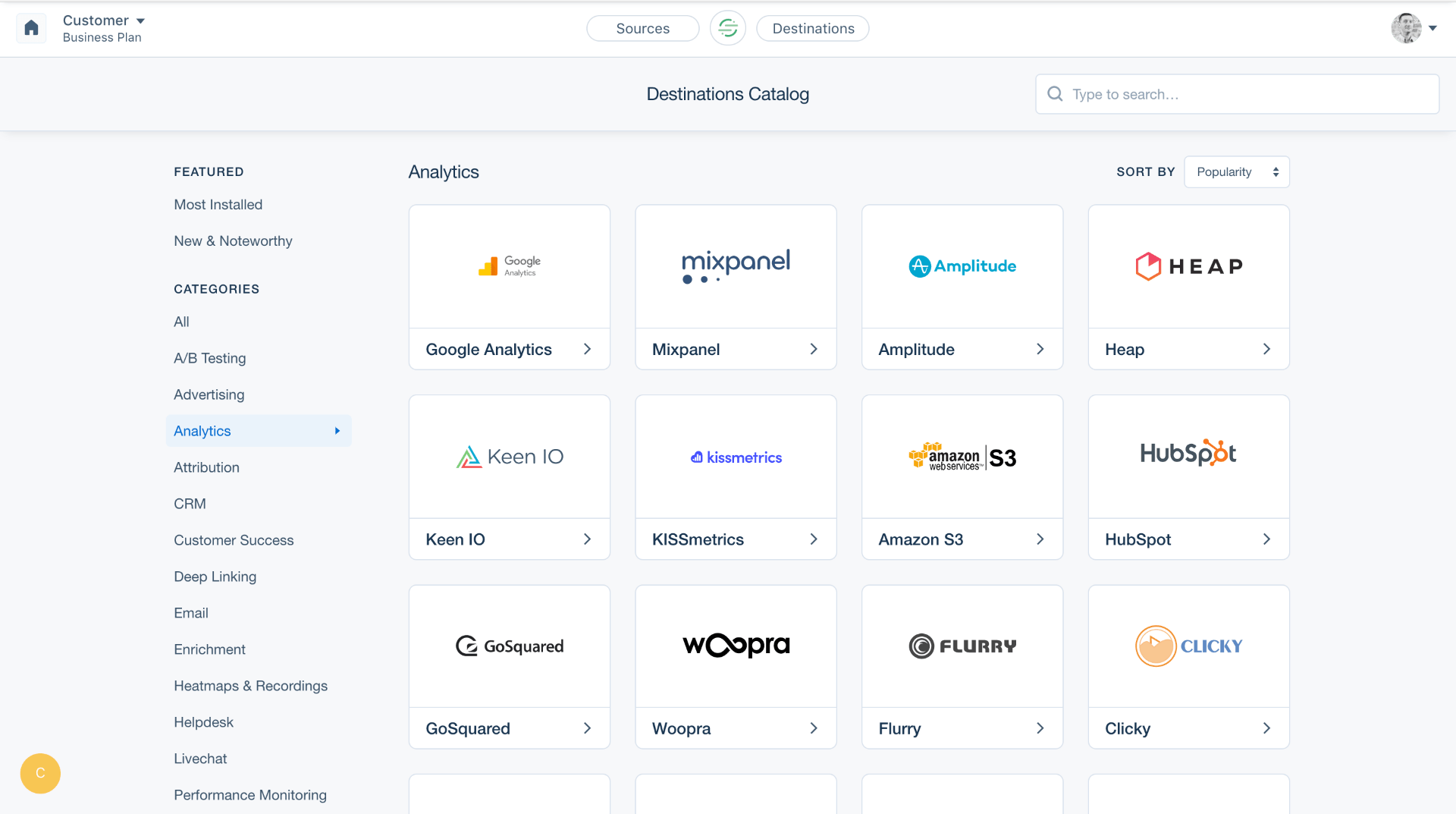
Segment is a customer data platform that helps you collect, clean, and activate your customer data. I have used Segment to integrate my web and mobile apps with analytics, marketing, and growth tools without writing code.
This tool has helped me simplify data collection, protect data integrity, personalize experiences, and maintain users’ privacy. Another Segment feature called Segment AI allowed me to build and deploy AI models on my customer data.
The software integrates with popular tools like Google Cloud AI Platform, Amazon SageMaker, and Azure Machine Learning.
What you’ll like:
- Audience builder that helps you create and manage user segments based on various criteria.
- Protocols to validate and standardize your user data quality and structure.
- Segment Identity Resolution to create unified profiles of your users based on their attributes and behaviors.
- Warehouse to store queries and user data in a cloud-based system.
What you may not like:
- Segment’s advanced capabilities can be overwhelming for beginners.
- The software does not offer analytics or visualization features.
Pricing: Free plan available (limited to 1000 visitors/month). Paid plan starts at $120/month.
Get the Best Customer Engagement Tools for Your Business
While I have provided you with a list of the 12 best customer engagement tools, the software you choose will depend on your objectives and business needs.
For example, if your goal is to understand your customer experience, you can choose Qualaroo, if you want to improve your customer support, go with ProProfs Chat, and if user analytics is your objective, you can pick Google Analytics.
So, take the time to assess your objectives, and choose the tool that aligns perfectly with your business goals.
Learn More About Customer Engagement Tools!
Q1: What is customer engagement?
Customer engagement refers to all the interactions and activities a business deploys to increase brand awareness, build customer loyalty, and promote a positive customer experience. This can be achieved using various touchpoints, including marketing campaigns, web content, social media, surveys, etc.
Q2: What are the key reasons businesses invest in customer engagement tools?
Customer engagement tools are software solutions that help businesses interact with their customers across various channels and touchpoints, such as websites, social media, email, chat, phone, etc. Some of the key reasons businesses invest in customer engagement tools are:
- Increasing customer satisfaction and loyalty by providing personalized, timely, relevant communication and support.
- Boosting customer retention and revenue by creating long-term relationships and cross-selling or upselling opportunities.
- Improving customer feedback and insights by collecting and analyzing data on customer behavior, preferences, needs, and pain points.
- Deriving structured and actionable insights through data extraction from unstructured customer feedback across multiple sources
- Enhancing customer advocacy and referrals by encouraging customers to share their positive experiences and reviews with others.
Q3: How do you choose the right customer engagement tool?
Choosing the best customer engagement tool requires careful consideration of your specific needs and goals. Here are steps to guide your selection process:
- Define Your Objectives: Begin by clearly defining your objectives and what you want to achieve with the tool, such as improving customer support, increasing sales, or enhancing customer relationships.
- Assess Your Budget: Determine your budget for the tool, including the initial purchase or subscription costs and ongoing maintenance and training expenses.
- Identify Key Features: List essential features you need, such as automation, CRM integration, multi-channel support, analytics, and scalability.
- User-Friendly Interface: Ensure the tool has an intuitive interface that your team can easily navigate and utilize effectively.
- Integration Capabilities: Check if the tool can integrate with your existing software systems, like CRM, marketing automation, and e-commerce platforms.
- Security and Compliance: Ensure the tool complies with data security and privacy regulations relevant to your industry and location.
- User Reviews and Recommendations: Research customer reviews and seek recommendations from businesses in your industry to understand their experiences with the tool.
Q4: How can a customer engagement tool improve customer support?
A customer engagement tool can improve customer support by enabling you to:
- Provide faster and more convenient support across multiple channels and devices.
- Automate repetitive tasks and workflows, such as chatbots, ticketing, routing, etc.
- Deliver personalized and proactive support based on customer data and context.
- Monitor and measure customer satisfaction and feedback using surveys, ratings, reviews, etc.
- Identify and resolve customer issues and complaints before they escalate.
Q5: Can customer engagement tools integrate with other software systems we use?
Yes, most customer engagement tools can integrate with other software systems you use for your business, such as CRM, marketing, sales, e-commerce, accounting, etc. This can help you streamline processes, share data, and optimize performance. However, the level of integration may vary depending on the type and compatibility of the tools.
Therefore, it is advisable to check the integration options and requirements before choosing a customer engagement tool. Before selecting a customer engagement tool, it’s important to check its compatibility with the specific systems you use and confirm that the integration process is straightforward.
Q6: How do AI and machine learning play a role in customer engagement tools?
AI and machine learning enable machines to learn from data and perform tasks that normally require human intelligence. They play a vital role in customer engagement tools by helping you:
- Analyze large amounts of customer data and generate insights and recommendations.
- Segment and target customers based on their behavior, preferences, needs, etc.
- Personalize and optimize your communication and content for each customer.
- Predict customer behavior and outcomes, such as churn, retention, lifetime value, etc.
- Enhance your chatbots and voice assistants with natural language processing and understanding.
 Tips
Tips
We’d love to hear your tips & suggestions on this article!
FREE. All Features. FOREVER!
Try our Forever FREE account with all premium features!


 We'd love your feedback!
We'd love your feedback! Thanks for your feedback!
Thanks for your feedback!




